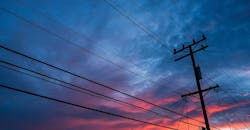According to data from the Energy Information Administration, wind power is set to surpass hydroelectric as the largest renewable energy source in the United States in 2019. As the nation transitions to greener energy, how can plant managers maintain facilities and substations on this ever-evolving grid? Mark Howard, United States country manager for EU Automation explains.
Few facilities can afford to have their operations halted by unexpected downtime. However, for the energy industry, unplanned stoppages have the potential to plunge entire regions into blackouts. For the US power grid — the largest electricity grid in the world — maintaining its 55,000 substations and 450,000 miles of high voltage transmission lines is essential to keeping the country’s lights on.
But the energy world is changing. The existing grid is largely designed around centralized power plants and one-way power flows — a system that doesn’t operate effectively with renewables because they generate energy at a far less predictable rate. Wind power, for instance, was responsible for 42% of electricity production in the US in 2018. However, the volatile nature of this energy source can cause complications.
A potentially destructive consequence of renewable energy is when supply surpasses demand and vice versa. Unlike traditional fossil fuels, wind power cannot be accurately managed, therefore renewables often supply too little or too much energy. Wind farms, for example, typically generate most of their energy at night, when energy demand is lowest, meaning that some energy is almost always wasted.
As with any energy generating operation, control and monitoring software is an essential way to keep this fluctuation under control and to manage potential blackouts. However, due to the aging infrastructure of many US substations, deploying this software and connecting it to renewable facilities often requires investment in new hardware.
Despite rapid progressions in renewable supply, keeping pace with the technological advancements of this sector simply isn’t feasible for most substations. However, due to the volatile nature of renewable sources, failure to upgrade could run the risk of unexpected downtime for these facilities. Transitioning to a smart grid should not require an entire systems overhaul. Instead, facilities managers should make small, incremental changes to better integrate renewable energy sources.
Deploying a compatible HMI, for instance, could provide substation operators with complete, real-time visualization of the renewable facilities that are feeding the grid. Using the wind farm example, an HMI could deliver data to inform the operator that the farm has experienced a sudden drop in power generation, allowing the operator to informatively switch to an alternative energy source.
Similarly, integration with renewable facilities could warn operators should there be a sudden rise in energy generation. Surges in energy generation like this can put enormous stress on the grid, causing short power outages and equipment failures. For unpredictable renewable sources, like wind and solar, the chances of energy surges are higher. Using technology to maintain communication between all areas of the grid could help avoid this problem.
Again, investing in new technology shouldn’t be inaccessible for existing substations and facilities on the grid. EU Automation specializes in providing new, used and obsolete industrial parts for applications like this. Providing HMIs and displays from manufacturers such as Schneider, ABB and Mitsubishi, EU Automation’s extensive stock can help facilities managers to upgrade their substations, without breaking the bank.
As renewable sources like hydroelectric and wind battle to become the largest contributor to that percentage, the existing grid must prepare to manage and distribute this ever-changing power supply.
About the Author
Mark Howard
Manager
Machines break and downtime can cost companies millions in lost revenue. Mark Howard and his multi-lingual team scour the globe to find quality obsolete, new and reconditioned parts to get industrial machines back up and running.
